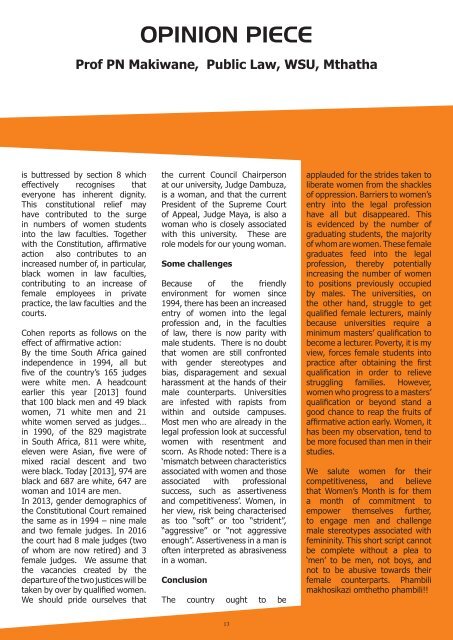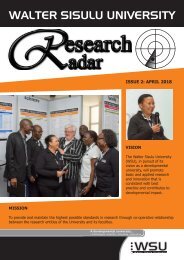Research Newsletter issue 2 April 2018
Create successful ePaper yourself
Turn your PDF publications into a flip-book with our unique Google optimized e-Paper software.
OPINION PIECE<br />
Prof PN Makiwane, Public Law, WSU, Mthatha<br />
is buttressed by section 8 which<br />
effectively recognises that<br />
everyone has inherent dignity.<br />
This constitutional relief may<br />
have contributed to the surge<br />
in numbers of women students<br />
into the law faculties. Together<br />
with the Constitution, affirmative<br />
action also contributes to an<br />
increased number of, in particular,<br />
black women in law faculties,<br />
contributing to an increase of<br />
female employees in private<br />
practice, the law faculties and the<br />
courts.<br />
Cohen reports as follows on the<br />
effect of affirmative action:<br />
By the time South Africa gained<br />
independence in 1994, all but<br />
five of the country’s 165 judges<br />
were white men. A headcount<br />
earlier this year [2013] found<br />
that 100 black men and 49 black<br />
women, 71 white men and 21<br />
white women served as judges…<br />
in 1990, of the 829 magistrate<br />
in South Africa, 811 were white,<br />
eleven were Asian, five were of<br />
mixed racial descent and two<br />
were black. Today [2013], 974 are<br />
black and 687 are white, 647 are<br />
woman and 1014 are men.<br />
In 2013, gender demographics of<br />
the Constitutional Court remained<br />
the same as in 1994 – nine male<br />
and two female judges. In 2016<br />
the court had 8 male judges (two<br />
of whom are now retired) and 3<br />
female judges. We assume that<br />
the vacancies created by the<br />
departure of the two justices will be<br />
taken by over by qualified women.<br />
We should pride ourselves that<br />
the current Council Chairperson<br />
at our university, Judge Dambuza,<br />
is a woman, and that the current<br />
President of the Supreme Court<br />
of Appeal, Judge Maya, is also a<br />
woman who is closely associated<br />
with this university. These are<br />
role models for our young woman.<br />
Some challenges<br />
Because of the friendly<br />
environment for women since<br />
1994, there has been an increased<br />
entry of women into the legal<br />
profession and, in the faculties<br />
of law, there is now parity with<br />
male students. There is no doubt<br />
that women are still confronted<br />
with gender stereotypes and<br />
bias, disparagement and sexual<br />
harassment at the hands of their<br />
male counterparts. Universities<br />
are infested with rapists from<br />
within and outside campuses.<br />
Most men who are already in the<br />
legal profession look at successful<br />
women with resentment and<br />
scorn. As Rhode noted: There is a<br />
‘mismatch between characteristics<br />
associated with women and those<br />
associated with professional<br />
success, such as assertiveness<br />
and competitiveness’. Women, in<br />
her view, risk being characterised<br />
as too “soft” or too “strident”,<br />
“aggressive” or “not aggressive<br />
enough”. Assertiveness in a man is<br />
often interpreted as abrasiveness<br />
in a woman.<br />
Conclusion<br />
The country ought to be<br />
applauded for the strides taken to<br />
liberate women from the shackles<br />
of oppression. Barriers to women’s<br />
entry into the legal profession<br />
have all but disappeared. This<br />
is evidenced by the number of<br />
graduating students, the majority<br />
of whom are women. These female<br />
graduates feed into the legal<br />
profession, thereby potentially<br />
increasing the number of women<br />
to positions previously occupied<br />
by males. The universities, on<br />
the other hand, struggle to get<br />
qualified female lecturers, mainly<br />
because universities require a<br />
minimum masters’ qualification to<br />
become a lecturer. Poverty, it is my<br />
view, forces female students into<br />
practice after obtaining the first<br />
qualification in order to relieve<br />
struggling families. However,<br />
women who progress to a masters’<br />
qualification or beyond stand a<br />
good chance to reap the fruits of<br />
affirmative action early. Women, it<br />
has been my observation, tend to<br />
be more focused than men in their<br />
studies.<br />
We salute women for their<br />
competitiveness, and believe<br />
that Women’s Month is for them<br />
a month of commitment to<br />
empower themselves further,<br />
to engage men and challenge<br />
male stereotypes associated with<br />
femininity. This short script cannot<br />
be complete without a plea to<br />
‘men’ to be men, not boys, and<br />
not to be abusive towards their<br />
female counterparts. Phambili<br />
makhosikazi omthetho phambili!!<br />
13



